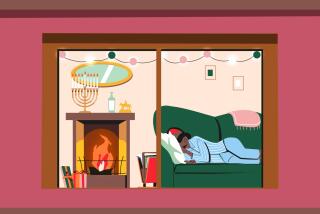Comforters Lend Down-Home Air
- Share via
Let’s see just how big a magnet for misfortune I can be: Today, we’re going to talk about down comforters.
“ Now he’s done it,” I can hear you moaning. “He’s just stuck us with another pre-fall heat wave. We’ll be sweltering in the mid-90s through Halloween.”
I don’t hear too many of you comforter owners screaming, though. You already know. Early fall in Southern California holds no nighttime terrors for you. If the heat soars toward three digits, you kick all the covers off like everybody else. From about 80 degrees on down, though, you tuck in deep. You know that the thing that looks like an elongated parka to your unenlightened friends is actually the designer equivalent of Linus’ blanket.
Down comforters traditionally have been a European staple. Take a little boat trip down the Rhine and you’ll see down comforters the size of cumulonimbus clouds in every bed-and-breakfast inn.
That’s where I found my first one, 18 years ago, in a little inn that was older than Beethoven’s great-grandfather. I was scared of it. It was The Bedding That Ate Miami. Lying beneath it, I was sure, would be like being wrestled to the ground by the Sta-Puft Marshmallow Man.
But it was surprisingly light and cottony and--the clincher--not hot. Even though it was summer, the comforter was airy and, well, comforting. Which, I suppose, is why they called it a comforter rather than a Bessemer converter.
So now is not a bad time to be thinking about buying one, no matter what Fritz and Dr. George say. But it is also a good time to be thinking, period. Not every comforter out there will make you think of gentle Rhineland zephyrs or toasty ski lodges, Sandra Marx says. They are not created equal.
First of all, says Marx, co-owner of Between the Sheets, a bed-and-bath shop in Fashion Island Newport Beach, you have to realize that down is not feathers. Feathers have shafts and quills that are stiff, prickly and decidedly not soft. Down, however, comes from the underside of the bird and looks like a little fibrous sun: a visible nucleus from which radiates incredibly soft strands.
The Federal Drug Administration stipulates that a comforter can be labeled “100% down” when it is 30% feather, says Marx (California has a stricter regulation, allowing only 25% feather).
The real winners come from Europe. Marx sells comforters made in Germany using Hungarian goose down. (“The geese are bred for it and it’s the cleanest in the world, unless your grandmother is at the kitchen table doing the sorting,” she says). The feather content is a mere 5%.
The high concentration of pure goose down not only makes for extraordinary lightness and softness, it allows air to circulate and become trapped in the comforter. This is the property that keeps the lightweight comforter covering you in temperatures between 45 and 80 degrees. (Heavier weights are available in colder climates.)
For still more lightness, the down of the comforters at Between the Sheets is encased in a cover of 307-thread-count cotton--extremely dense and lightweight.
Each quilted section of the comforter is bounded by small baffles that allow air to circulate between the sections.
“The air can get in, but it can’t get out, and the down never shifts,” Marx says.
How to make the bed? Think of the comforter as a kind of super blanket. Use a bottom and top sheet--light cotton is best, says Marx--and lay the comforter over it all. It acts as a blanket and, with the help of what is called a duvet (doo-VAY) cover, it also doubles as a bedspread. A duvet cover is a kind of large cotton pocket inside of which slips the comforter.
Duvet covers can be elaborate and highly decorative and generally are made from high thread count cotton, much the same as the comforter.
The result: “You have this weightless product on top of you at night, and you don’t toss and turn,” Marx says.
Anyone who owns a goose down parka knows a comforter won’t come cheaply. At Between the Sheets, king-size comforters sell for $995, queens for $799 and twins for $529. Duvet covers start at $295.
But, Marx says, with proper care--don’t sit on them (they can compact) and air them out a couple of times a year--a well-made European down comforter should last 10 to 15 years or more.
Which should give you plenty of time for one or two trips to the Rhineland, where you can stay at inns and castles and hotels that played host to Goethe and Schiller and Mozart, and where you can crawl into bed and feel, strangely and pleasantly, right at home.


